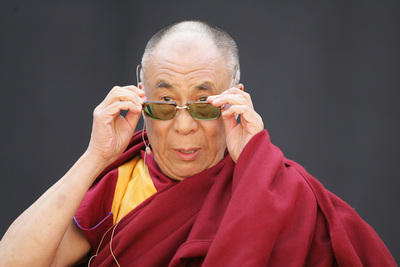Nara, Japan — Early on a bright and shining morning, His Holiness began the second day of his autumn tour of Japan by traveling across the Deer Park at the heart of the ancient Buddhist capital of Nara, to the modern Nara Prefecture Auditorium, where 250 or so Koreans filled a large room, standing up and greeting him when he appeared. To this Buddhist group, including many monks and nuns, he delivered a rigorous Buddhist talk on shunyata, and the powers of the mind.
Since our mind is sometimes afflicted with delusions, he says, what is needed to overcome them is in the mind, too. Wisdom, in short, which allows us to see past distortions to the true reality of things. That’s why Buddhism has so much material about the mind. Joining the group in a recitation of the Heart Sutra, he discussed the difference between focusing meditation and analytical meditation and talked about the importance, in the latter, of asking questions.
 “Wisdom means understanding emptiness,” he said, “and once you understand emptiness, you learn that the idea of an independent self is an illusion. Thus wisdom leads to bodhichita, or infinite compassion. But without making a sustained effort, none of this will happen.”
“Wisdom means understanding emptiness,” he said, “and once you understand emptiness, you learn that the idea of an independent self is an illusion. Thus wisdom leads to bodhichita, or infinite compassion. But without making a sustained effort, none of this will happen.”
His Holiness then proceeded, by car, across another stretch of the Deer Park, dozens of deer watching him among the groves of trees turning color in the autumn light, to Todaiji, the great central temple of Nara, dating from around the year 752, and joined a group of monks from different local groups in praying before the Daibutsu, or Great Buddha. Huge crowds of visiting tourists from the West, local Japanese and school-tour groups lined the path to the temple as he approached the central hall in the sun, calling out to him and jostling to shake his hand.
After paying their respects to the Great Buddha, His Holiness and the monks went to a sleek modern auditorium not far away in the Todaiji complex, and His Holiness delivered a talk on Buddhist practice to about 350 people, many of them monks and their families. He described his own practice, his constant checking of his observance of his central vows, the review he makes at the end of each day of how well he has honored these vows.
You cannot make Buddhism simple, he stressed; there are no short-cuts. The only thing is to study. In Wisconsin, in the U.S., over 200 public schools have, since September, instituted the teaching of meditation, because scientists there and elsewhere have found what positive results it can have.
“It can be better to print sutras and distribute them,” he said, “than just to build more statues of the Buddha. What we need is teaching, study of the Dharma, and statues do not teach us. Rather than building a grand monastery, it’s sometimes better to build a learning center, going to the roof of things. The 21st century Buddhist must have full knowledge of science and secular matters, and full knowledge of Buddhism, too.”
After lunch with his hosts at Todaiji, and other monks, of all denominations, from Nara’s Buddhist community–over talk about the importance of religious tolerance–His Holiness returned to the central temple, often called the largest wooden building in the world (its great Buddha the largest bronze statue). Proceeding in through cheering crowds once again, he took his place in front of the temple’s huge wooden back doors, autumn light streaming through the maples and changing foliage all around, and delivered a talk on how we can work with karma, or the law of causality, to contribute to peace and the environment.
As 2000 or so sat before him on folding chairs in the autumn light–large groups of Koreans, many schoolchildren, Japanese who had traveled from far away–he spoke how often, if you use force, it leads to counter-force, and only more violence. “In the short term a gun is very decisive; in the long run it cannot solve any problem.
“Force,” he explained, “is an unrealistic method. And any unrealistic method never brings a satisfactory result. That’s quite clear, scientifically proven. Even if you want to hit someone, if you’re angry, and you flail out, you may only hit your hand!” As the sun came in through the trees, His Holiness asked if the audience would mind his speaking a little longer and, in answer to their cheers, expanded on the importance of peace and took questions from every corner, concentrating especially on the schoolchildren. “Investigate,” he emphasized, “study work, work hard” and almost everything is possible.
– Source : Buddhistchannel




